The sample comprises 60 participants, the majority of which are female (n=36), representing a percentage of 60%, and the remainder are male (n=24), representing 40%. The group of individuals who play volleyball (n=28; 14 male, 14 female) corresponds to a percentage of 46.67% and the group of individuals who do not play volleyball (n=32; 10 male, 22 female) corresponds to 53.33%.
The sample had individuals with a minimum age of 18 and a maximum age of 28. Forty-eight individuals aged between 18 and 21 years, representing 80% and 6 individuals whose age range is between 22 and 25 years old, which represent 10% and 6 individuals were registered in the age range of 26 to 29 years old, which represent 10%. Most of the participants indicated the right limb as being their dominant member (DM), with 33 female participants representing 55% and 23 male participants (38.33%). As for the left limb, 3 female participants (5%) and 1 male participant presented it as DM. In Table 1, it is possible to observe the values relative to the measurement of the supraspinatus tendon according to these groups.
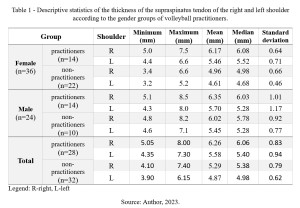
In the study sample, the tendon is thicker in males than in females, thicker in volleyball players than in non-volleyball players, and thicker depending on age, height, dominant upper limb, and volleyball practice (Table 2).
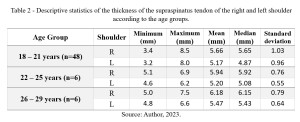
Individuals who practice volleyball have an average thickness of the supra spinous tendon of the right limb of 6.26 mm and of the left limb of 5.58 mm. The ones who do not practice volleyball have an average thickness of the tendon of the supraspinatus muscle of the right limb of 5.29 mm and of the left limb of 4.87 mm (Table 3).
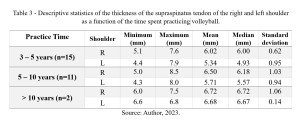
Regarding the comparative analysis between the thickness of the supraspinatus tendon and the group under study, it is possible to conclude that there are statistically significant differences between both groups, p=0.001 for the right tendon and p= 0.02 for the left tendon.
The Bonferroni post-hoc test (Table 4) indicates that there are statistically significant differences in the measurements of the thickness of the supraspinatus tendon for both the right and left limbs between the “Female practitioner” group and the “Female non-practitioner” group (p<0.05), with no statistically significant differences between this first group and the “Male practitioner” and “Male non-practitioner” groups (p>0.05). Also for both upper limbs, there are statistically significant differences between the “Female non-practitioner” group and the “Male practitioner” and “Male non-practitioner” groups (p<0.05), with no statistically significant differences between the “Male practitioner” group and the “Male non-practitioner” group (p>0.05).
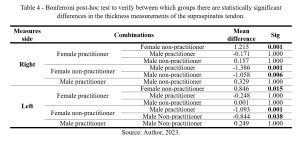
As for the value of the mean difference, if this is negative, it is assumed that the values ​​of the first group are smaller than the values ​​of the second group in comparison with a variable. That said, it is possible to conclude that, for both the right upper limb and the left upper limb, the “Female practitioner” group presents higher supraspinatus tendon thickness values ​​than the “Female non- practitioner” group but presents lower values ​​than the “Male practitioner” and “Male non-practitioner” groups. It is observed that the group “Female non-practitioner” presents lower values ​​than the groups “Male practitioner” and “Male non-practitioner”. It is also observed that the “Male practitioner” group presents greater values ​​of supraspinatus tendon thickness” than the “Male non-practitioner” group.
It can be concluded that practitioners have a thicker supraspinatus tendon when compared to non-practitioners.
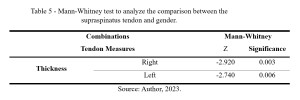
Based on the analysis of Table 5, it was found that the thickness of the supraspinatus tendons differed statistically significantly between genders since the significance obtained a p-value < 0.05 in both cases, thus rejecting the null hypothesis.
When Z presents negative values, the values of the first group are smaller than the values of the second group. As the first group corresponds to the female gender, it is possible to conclude that female individuals present lower values of supraspinatus tendon thickness in both limbs than male individuals.
The results of our study are in line with those obtained by Karthikeyan et al. (2014), where the dominant limb has a significant influence on the thickness of the supraspinatus tendon (p<0.05), presenting higher values in the dominant limb when compared to the non-dominant limb. Also, volleyball practitioners present an increase in the thickness of the supraspinatus tendon due to overstrain when compared to non-practitioners.
As a limitation, along with the sample size, there is a scarce bibliography on elastography, specifically on studying the supraspinatus tendon in volleyball practitioners. Additionally, the researcher who collected the data spent a short period practising the technique, which is why only the colour map relating to elastography was collected.